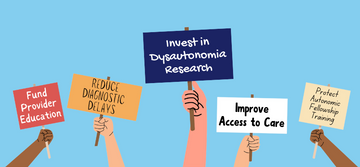
Being diagnosed with POTS can be a scary, frustrating, or even validating experience. No matter the emotion, you are being hit with something new in your life. Most people go directly to Google to find out more information, however you can be overloaded and overwhelmed at times, especially when it comes to misinformation. We’ve compiled some general information and tips for you to help you through your journey.
What is dysautonomia?
Dysautonomia is a medical term that represents a malfunction of the autonomic nervous system. This system controls the “automatic” functions of the body that we do not consciously think about, such as heart rate, blood pressure, digestion, dilation and constriction of the pupils of the eye, kidney function and temperature control. There are several forms of dysautonomia, including Postural Orthostatic Tachycardia Syndrome (POTS), as well as Neurocardiogenic Syncope (Vasovagal Syncope), Inappropriate Sinus Tachycardia (IST) and Multiple System Atrophy.
I was diagnosed with POTS, but what does that mean?
POTS is an autonomic nervous system disorder. In order to be diagnosed, you need to have a heart rate increase of 30 beats per minute (bpm) or more, or over 120 bpm, within the first 10 minutes of standing, without low blood pressure upon standing. People living with various forms of dysautonomia have trouble regulating these systems, which can result in lightheadedness, fainting, unstable blood pressure, abnormal heart rates, and malnutrition. To help manage these symptoms, many patients have been advised to increase both fluid and salt intake in order to increase blood volume.
Help, now what do I do?
Breathe! Here are some tips that we recommend to help start you on your journey:
- Research your condition from credible resources. The more you know, the more you can help yourself.
- Advocate for yourself by making sure you have a provider who understands your condition and by asking questions. Some websites like Dysautonomia International and PoTS UK are a helpful starting point.
- There is no cure for most forms of dysautonomia, but there are lifestyle adjustments (more on this below) and medication that can help manage symptoms.
- There is not a "one size fits all" treatment and there may be some trial and error until you and your medical provider find what works for you.
- Try to identify triggers, like sitting or standing for long periods of time, heat or certain foods.
- Connect with the community through support groups and social media. You can find us on Facebook, Tik Tok and Instagram: @Vitassium
- Get a blood pressure monitor and pulse oximeter to track your blood pressure and heart rate.
- Get a medical ID bracelet, especially if you’re prone to fainting.
- Always carry essentials with you like fluids, medications, salt capsules or tabs, or salty snacks.
There is a long waitlist for my doctor. Are there things I can do in the meantime to help me feel better?
We recommend ALWAYS checking with a provider before you begin any type of treatment protocol or lifestyle modifications. As we mentioned before, there is not a "one size fits all" treatment for POTS and there may be some trial and error until you and your medical provider find what works for you. However, there are some suggestions for common POTS lifestyle modifications that can be tried:
- Wear compression garments like socks and leggings to help blood circulation. There are many places you can get these, including Etsy where some of the shops are founded by people with chronic illness.
- Use mobility aids if you find it difficult to stand or walk long distances
- Always sit up and stand up slowly
- Do counter maneuvers before and while standing to help prevent syncope
- Put your legs up on the wall to help decrease your heart rate
- Sit down as often as possible, like while cooking, cleaning or doing your hair
- Find a dysautonomia friendly shower routine, like this one
- Avoid bending over — instead, bend at your knees or use a grabber tool to pick up small objects
- Eat small, frequent meals instead of large meals, which can worsen symptoms. Keep a food diary — some patients find that they feel better when avoiding simple carbohydrates, gluten, dairy and/or caffeine, while other patients find caffeine helps their symptoms
- Avoid alcohol, which can cause dehydration and hypotension
- Increase your fluid and salt intake to boost blood volume — this may be done through IV fluid, or products like Vitassium, which is specifically designed to provide electrolytes to people with dysautonomia and other chronic conditions
Looking for more suggestions? Check out our helpful tip sheet and follow us on social media for more relatable hints and tricks!








